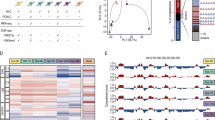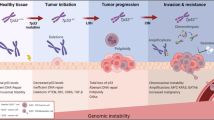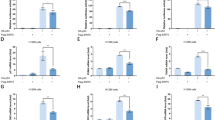Abstract
The tumor suppressor p53 is essential for several cellular processes that are involved in the response to diverse genotoxic stress, including cell cycle arrest, DNA repair, apoptosis and senescence. Studies of the regulation of p53 have mostly focused on its stability and transactivation; however, new regulatory molecules for p53 have also been frequently identified. Here, we report that human ssDNA binding protein SSB1 (hSSB1), a novel DNA damage-associated protein, can interact with p53 and protect p53 from ubiquitin-mediated degradation. Furthermore, hSSB1 also associates with the acetyltransferase p300 and is required for efficient transcriptional activation of the p53 target gene p21 by affecting the acetylation of p53 at lysine382. Functionally, the hSSB1 knockdown-induced abrogation of the G2/M checkpoint is partially dependent on p53 or p300. Collectively, our results indicate that hSSB1 may regulate DNA damage checkpoints by positively modulating p53 and its downstream target p21.
Similar content being viewed by others
Log in or create a free account to read this content
Gain free access to this article, as well as selected content from this journal and more on nature.com
or
References
Levine AJ, Hu W, Feng Z . The P53 pathway: what questions remain to be explored? Cell Death Differ 2006; 13:1027–1036.
Vousden KH, Prives C . Blinded by the light: The growing complexity of p53. Cell 2009; 137:413–431.
Vousden KH, Lu X . Live or let die: the cell's response to p53. Nat Rev Cancer 2002; 2:594–604.
Riley T, Sontag E, Chen P, Levine A . Transcriptional control of human p53-regulated genes. Nat Rev Mol Cell Biol 2008; 9:402–412.
Bode AM, Dong Z . Post-translational modification of p53 in tumorigenesis. Nat Rev Cancer 2004; 4:793–805.
Dai C, Gu W . p53 post-translational modification: deregulated in tumorigenesis. Trends Mol Med 2010; 16:528–536.
Brooks CL, Gu W . New insights into p53 activation. Cell Res 2010; 20:614–621.
Kruse JP, Gu W . Modes of p53 regulation. Cell 2009; 137:609–622.
Brooks CL, Gu W . The impact of acetylation and deacetylation on the p53 pathway. Protein Cell 2011; 2:456–462.
Taira N, Yoshida K . Post-translational modifications of p53 tumor suppressor: determinants of its functional targets. Histol Histopathol 2012; 27:437–443.
Haupt Y, Maya R, Kazaz A, Oren M . Mdm2 promotes the rapid degradation of p53. Nature 1997; 387:296–299.
Kubbutat MH, Jones SN, Vousden KH . Regulation of p53 stability by Mdm2. Nature 1997; 387:299–303.
Colombo E, Marine JC, Danovi D, Falini B, Pelicci PG . Nucleophosmin regulates the stability and transcriptional activity of p53. Nat Cell Biol 2002; 4:529–533.
Colaluca IN, Tosoni D, Nuciforo P, et al. NUMB controls p53 tumour suppressor activity. Nature 2008; 451:76–80.
Kuo PC, Tsao YP, Chang HW, et al. Breast cancer amplified sequence 2, a novel negative regulator of the p53 tumor suppressor. Cancer Res 2009; 69:8877–8885.
Lukas J, Lukas C, Bartek J . More than just a focus: The chromatin response to DNA damage and its role in genome integrity maintenance. Nat Cell Biol 2011; 13:1161–1169.
Drost J, Mantovani F, Tocco F, et al. BRD7 is a candidate tumour suppressor gene required for p53 function. Nat Cell Biol 2010; 12:380–389.
Wold MS . Replication protein A: a heterotrimeric, single-stranded DNA-binding protein required for eukaryotic DNA metabolism. Annu Rev Biochem 1997; 66:61–92.
Richard DJ, Bolderson E, Khanna KK . Multiple human single-stranded DNA binding proteins function in genome maintenance: structural, biochemical and functional analysis. Crit Rev Biochem Mol Biol 2009; 44:98–116.
Oakley GG, Patrick SM . Replication protein A: directing traffic at the intersection of replication and repair. Front Biosci 2010; 15:883–900.
Richard DJ, Bolderson E, Cubeddu L, et al. Single-stranded DNA-binding protein hSSB1 is critical for genomic stability. Nature 2008; 453:677–681.
Li Y, Bolderson E, Kumar R, et al. HSSB1 and hSSB2 form similar multiprotein complexes that participate in DNA damage response. J Biol Chem 2009; 284:23525–23531.
Huang J, Gong Z, Ghosal G, Chen J . SOSS complexes participate in the maintenance of genomic stability. Mol Cell 2009; 35:384–393.
Skaar JR, Richard DJ, Saraf A, et al. INTS3 controls the hSSB1-mediated DNA damage response. J Cell Biol 2009; 187:25–32.
Zhang F, Wu J, Yu X . Integrator3, a partner of single-stranded DNA-binding protein 1, participates in the DNA damage response. J Biol Chem 2009; 284:30408–30415.
Richard DJ, Cubeddu L, Urquhart AJ, et al. hSSB1 interacts directly with the MRN complex stimulating its recruitment to DNA double-strand breaks and its endo-nuclease activity. Nucleic Acids Res 2011; 39:3643–3651.
Richard DJ, Savage K, Bolderson E, et al. hSSB1 rapidly binds at the sites of DNA double-strand breaks and is required for the efficient recruitment of the MRN complex. Nucleic Acids Res 2011; 39:1692–1702.
Xu S, Feng Z, Zhang M, et al. hSSB1 binds and protects p21 from ubiquitin-mediated degradation and positively correlates with p21 in human hepatocellular carcinomas. Oncogene 2011; 30:2219–2229.
Dutta A, Ruppert JM, Aster JC, Winchester E . Inhibition of DNA replication factor RPA by p53. Nature 1993; 365:79–82.
Abramova NA, Russell J, Botchan M, Li R . Interaction between replication protein A and p53 is disrupted after UV damage in a DNA repair-dependent manner. Proc Natl Acad Sci USA 1997; 94:7186–7191.
Romanova LY, Willers H, Blagosklonny MV, Powell SN . The interaction of p53 with replication protein A mediates suppression of homologous recombination. Oncogene 2004; 23:9025–9033.
Bochkareva E, Kaustov L, Ayed A, et al. Single-stranded DNA mimicry in the p53 transactivation domain interaction with replication protein A. Proc Natl Acad Sci USA 2005; 102:15412–15417.
Olsson A, Manzl C, Strasser A, Villunger A . How important are post-translational modifications in p53 for selectivity in target-gene transcription and tumour suppression? Cell Death Differ 2007; 14:1561–1575.
Liu L, Scolnick DM, Trievel RC, et al. p53 sites acetylated in vitro by PCAF and p300 are acetylated in vivo in response to DNA damage. Mol Cell Biol 1999; 19:1202–1209.
Lill NL, Grossman SR, Ginsberg D, DeCaprio J, Livingston DM . Binding and modulation of p53 by p300/CBP coactivators. Nature 1997; 387:823–827.
Avantaggiati ML, Ogryzko V, Gardner K, Giordano A, Levine AS, Kelly K . Recruitment of p300/CBP in p53-dependent signal pathways. Cell 1997; 89:1175–1184.
Gu W, Roeder RG . Activation of p53 sequence-specific DNA binding by acetylation of the p53 C-terminal domain. Cell 1997; 90:595–606.
Barlev NA, Liu L, Chehab NH, et al. Acetylation of p53 activates transcription through recruitment of coactivators/histone acetyltransferases. Mol Cell 2001; 8:1243–1254.
Zhao Y, Lu S, Wu L, et al. Acetylation of p53 at lysine 373/382 by the histone deacetylase inhibitor depsipeptide induces expression of p21(Waf1/Cip1). Mol Cell Biol 2006; 26:2782–2790.
Kitagawa M, Lee SH, McCormick F . Skp2 suppresses p53-dependent apoptosis by inhibiting p300. Mol Cell 2008; 29:217–231.
Hollstein M, Sidransky D, Vogelstein B, Harris CC . p53 mutations in human cancers. Science 1991; 253:49–53.
Li M, Brooks CL, Wu-Baer F, Chen D, Baer R, Gu W . Mono- versus polyubiquitination: differential control of p53 fate by Mdm2. Science 2003; 302:1972–1975.
Rodriguez MS, Desterro JM, Lain S, Lane DP, Hay RT . Multiple C-terminal lysine residues target p53 for ubiquitin-proteasome-mediated degradation. Mol Cell Biol 2000; 20:8458–8467.
Li M, Luo J, Brooks CL, Gu W . Acetylation of p53 inhibits its ubiquitination by Mdm2. J Biol Chem 2002; 277:50607–50611.
Lv XB, Xie F, Hu K, et al. Damaged DNA-binding protein 1 (DDB1) interacts with Cdh1 and modulates the function of APC/CCdh1. J Biol Chem 2010; 285:18234–18240.
Xiao J, Zhang Z, Chen GG, et al. Nucleophosmin/B23 interacts with p21WAF1/CIP1 and contributes to its stability. Cell Cycle 2009; 8:889–895.
el-Deiry WS, Tokino T, Velculescu VE, et al. WAF1, a potential mediator of p53 tumor suppression. Cell 1993; 75:817–825.
Ceraline J, Deplanque G, Duclos B, et al. Inactivation of p53 in normal human cells increases G2/M arrest and sensitivity to DNA-damaging agents. Int J Cancer 1998; 75:432–438.
Bunz F, Dutriaux A, Lengauer C, et al. Requirement for p53 and p21 to sustain G2 arrest after DNA damage. Science 1998; 282:1497–1501.
Ando T, Kawabe T, Ohara H, Ducommun B, Itoh M, Okamoto T . Involvement of the interaction between p21 and proliferating cell nuclear antigen for the maintenance of G2/M arrest after DNA damage. J Biol Chem 2001; 276:42971–42977.
Lobrich M, Jeggo PA . The impact of a negligent G2/M checkpoint on genomic instability and cancer induction. Nat Rev Cancer 2007; 7:861–869.
Bucher N, Britten CD . G2 checkpoint abrogation and checkpoint kinase-1 targeting in the treatment of cancer. Br J Cancer 2008; 98:523–528.
Kang T, Wei Y, Honaker Y, et al. GSK-3 beta targets Cdc25A for ubiquitin-mediated proteolysis, and GSK-3 beta inactivation correlates with Cdc25A overproduction in human cancers. Cancer Cell 2008; 13:36–47.
Chen MS, Ryan CE, Piwnica-Worms H . Chk1 kinase negatively regulates mitotic function of Cdc25A phosphatase through 14-3-3 binding. Mol Cell Biol 2003; 23:7488–7497.
Acknowledgements
We thank the members of the laboratory for their helpful comments on the manuscript. This work was supported by the National Basic Research Program of China (2010CB912201 and 2012CB967000 to TK), and the National Natural Science Foundation of China (81171890 to SL, 81125015 and 30930045 to TK).
Author information
Authors and Affiliations
Corresponding author
Additional information
( Supplementary information is linked to the online version of the paper on the Cell Research website.)
Supplementary information
Supplementary information, Figure S1
HEK293T cells transfected with the indicated plasmids for 24 h were lysed with MCLB. (PDF 67 kb)
Supplementary information, Figure S2
HepG2 cells were transfected with scrambled or hSSB1 siRNAs as indicated for 48 h, and mRNA was extracted and detected by microarray chip. (PDF 38 kb)
Supplementary information, Figure S3
HepG2 cells transfected with scrambled or hSSB1 siRNA for 24 h were transfected with p21, p53, p300 plasmids or control as indicated for 8 h, and then nocodazole (100 ng/ml) was added for another 16 h, followed by flow cytometry (n = 3). (PDF 209 kb)
Supplementary information, Figure S4
HepG2 cells were transfected with scrambled or hSSB1 siRNAs for 6 h, and then treated with doxorubicin (DOX, 1 μM), after 48h the cells were subjected to annexin V-EGFP/propidium iodide staining, and analyzed by flow cytometry (n = 3). (PDF 172 kb)
Supplementary information, Table S1
Sequences of primers used for Real-time quantitative PCR (PDF 9 kb)
Supplementary information, Table S2
Ratio=B / S, significantly differentially expressed genes:20 (XLS 7967 kb)
Rights and permissions
About this article
Cite this article
Xu, S., Wu, Y., Chen, Q. et al. hSSB1 regulates both the stability and the transcriptional activity of p53. Cell Res 23, 423–435 (2013). https://doi.org/10.1038/cr.2012.162
Received:
Revised:
Accepted:
Published:
Issue date:
DOI: https://doi.org/10.1038/cr.2012.162
Keywords
This article is cited by
-
KLF12 promotes the proliferation of breast cancer cells by reducing the transcription of p21 in a p53-dependent and p53-independent manner
Cell Death & Disease (2023)
-
SOSSB1 and SOSSB2 mutually regulate protein stability through competitive binding of SOSSA
Cell Death Discovery (2023)
-
UBE2O targets Mxi1 for ubiquitination and degradation to promote lung cancer progression and radioresistance
Cell Death & Differentiation (2021)
-
Forcing ATGL expression in hepatocarcinoma cells imposes glycolytic rewiring through PPAR-α/p300-mediated acetylation of p53
Oncogene (2019)
-
RETRACTED ARTICLE: MNAT1 is overexpressed in colorectal cancer and mediates p53 ubiquitin-degradation to promote colorectal cancer malignance
Journal of Experimental & Clinical Cancer Research (2018)



